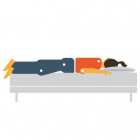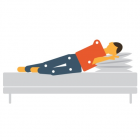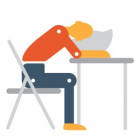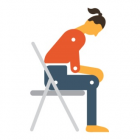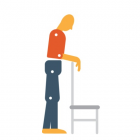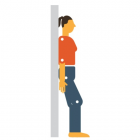Managing Long COVID
Tips and tricks for managing Long COVID and looking after yourself
Managing Long COVID will be different for everyone as people's experiences are unique to them. Living with Long COVID can be really hard and challenging at times and therefore it is important to go easy on yourself during this time.
Sometimes you may feel alone but is important to remember you are not alone, not only are there millions of people worldwide who have experienced Long COVID but there are health professionals that can support you during this time.
“Although it might sometimes feel like it know that you are not alone”
 Long COVID doesn’t just affect people physically it can also affect other parts of a person’s wellbeing such as their mental health. To manage long COVID you need to take care of the different aspects of your life that support good wellbeing. The Māori model of health te whare tapa whā developed by Sir Mason Durie in 1984 uses the wharenui (meeting house) and its four walls to symbolise the different dimensions of health that contribute to wellbeing. The connection with the whenua (land) forms the foundation for 4 dimensions. The wharenui is strengthened by its four walls and secure foundation. Similarly, we are at our strongest when each dimension of our health is cared for. When any of the dimensions are challenged, we can draw strength from our foundation or another dimension to balance and strengthen our overall wellbeing. You may want to consider these different dimensions in relation to taking care of yourself during Long COVID.
Long COVID doesn’t just affect people physically it can also affect other parts of a person’s wellbeing such as their mental health. To manage long COVID you need to take care of the different aspects of your life that support good wellbeing. The Māori model of health te whare tapa whā developed by Sir Mason Durie in 1984 uses the wharenui (meeting house) and its four walls to symbolise the different dimensions of health that contribute to wellbeing. The connection with the whenua (land) forms the foundation for 4 dimensions. The wharenui is strengthened by its four walls and secure foundation. Similarly, we are at our strongest when each dimension of our health is cared for. When any of the dimensions are challenged, we can draw strength from our foundation or another dimension to balance and strengthen our overall wellbeing. You may want to consider these different dimensions in relation to taking care of yourself during Long COVID.
Experiencing long COVID may mean that you are dealing with challenging physical symptoms. The symptoms may not only change how your body feels but also how you move, grow, and take care of your body. Some key things to take care of your taha tinana during this time are to prioritise sleep, eat regular and nutritious meals, and be kind to yourself by gradually increasing your activity levels. Read tips on sleep, self-care, pacing, and exercise. All of which will help you strengthen your taha tinana.
Experiencing long COVID can be difficult and impact your mental and emotional wellbeing. Taha hinengaro is not only about how you feel but also about how you communicate and think. Taking care of your taha hinengaro will help you better cope with long COVID and the challenges that may come with it. Some key things to nurture your taha hinengaro during this time are to reach out to your friends, whānau, and hoamahi (colleagues). Sleeping and eating well, staying active, and allowing time for relaxation are also important for your taha hinengaro. Read tips on self-care, sleep, coping with brain fog or cognitive changes, and how to talk about long COVID.
There is no single way to view wairua. For some it involves faith and religious beliefs, for others wairua may be viewed as a deep sense of interconnectedness to the universe or the sacred. You may have beliefs, values, traditions, and practises that support your identity and help you connect with yourself, whanau, community, nature, or the sacred. Read some tips for self-care and strengthening your wairua.
Taha whānau involves your well-being, those you care about, and those who make you feel like you belong. Taha whānau can include your extended relationships, including your friends, hoamahi (colleagues), and community. Strengthen your taha whānau by spending time with your loved ones or letting them help you with the challenges of Long Covid. Your whānau can support your identity and overall well-being. We know it can be challenging to explain to whānau what living with Long COVID feels like; you can find some tips to help with this here.
Other cultures and groups also have similar models that include the different elements of health and wellbeing such as the Pacific Fonofale model of health developed by Fuimaono Karl Pulotu-Endemann. View more information about Pacific models of health.
The following are some tips and tricks that people experiencing Long COVID may find useful to help take care of themselves during this time and manage some of the symptoms they are experiencing.
 |
Self-care - taking care of your Taha Wairua |
When stressful situations such as Long COVID continue for an extended period of time, it is common to feel less able to cope with everyday tasks. You might feel stressed or notice changes in mood, concentration, and energy. Self-care helps reduce stress and feelings of frustration, improves low mood and concentration, and boosts your energy and happiness. By taking care of yourself you will be better able to cope with your Long COVID. Self-care includes good nutrition, quality sleep, exercise, and relaxation to help you recharge your physical and emotional batteries and strengthen your wairua.
The following are some activities and tips to help take care of yourself during this time.
Physical health conditions can often affect your mental health too, and Long COVID is not an exception to this. It is well understood that living with Long COVID has an impact on our mental health. It’s important to acknowledge the emotions that arise for you and to seek help for these if needed.
Some common emotional experiences include:
- Feelings of isolation and loneliness. You may feel alone in your Long COVID experience particularly if your friends and family have no experience with the condition.
- Low mood. It is normal to feel down when you are physically unwell or when you aren’t able to do the things you want to do. Some people describe feeling flat or not getting as much joy from good things.
- Anxiety, worry and fear. Worry and anxiety about your symptoms as well as worry about the impacts of these on your life such as your ability to work are common. With little known about Long COVID you may also be worried or fearful about the future and when your Long COVID might end.
- Anger and frustration. You may experience anger and frustration about Long COVID or the lack of treatment and support
- Feelings of grief and loss. There can be lots of reasons you might feel grief and loss, from grieving all the things you can’t do now with Long COVID or you could be grieving loved ones who passed away from COVID-19.
Know that these emotions are normal and valid, and there are other emotions you might feel too. These emotions may come and go but should not feel so overwhelming that you are not able to cope.
If these emotions become overwhelming or you are struggling to cope it is very important to talk to someone or seek help from a professional.
Things that you can do that might help:
- Try and have a daily routine and plan nice activities regularly.
- Talk to people you trust about how you are feeling.
- Practice relaxation, mindfulness, meditation or prayer.
- Try to eat well, sleep well and exercise safely.
- Join a support group, either face-to-face or online.
“An unexpected thing is the grief. I am grieving my old (busy, active, happy) life. I don't know when I will be back to my old life and I don't know how to get there. It is like being stuck in a very depressing copy of your life that is mostly revolving around the sofa and the bed - not revolving around my priorities.... Family, my friends, my work, my passions and my activities. I have become so homebound and so ill and I miss my old life. There is a real sense of loss "of the way things were" and a heap of uncertainty about how/when will I be well again...and this feels to me at the moment, a bit like grief.”
Sharing concerns and challenges with whānau, friends or a professional can help to relieve stress and build resilience. If you don’t feel up to in person catch ups remember keeping in touch via messages or over the phone is great too.
- If you would like to talk to others with Long COVID you could join a support group.
- If you would like to talk to a professional, there are lots of services available to talk to.
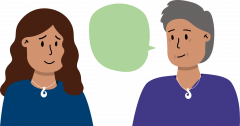 If you are not sure how to talk to others about Long COVID, you can find some tips here.
If you are not sure how to talk to others about Long COVID, you can find some tips here.
Remember, sometimes talking to someone about things other than Long COVID can help distract from symptoms and help to improve your mood. If you feel this might help you can tell people that you don’t feel like talking about Long COVID right now and would prefer to talk about something else.
Dealing with COVID can be difficult and isolating at times. It is important to stay connected with your loved ones to help you feel happy and healthy. Socialising with friends and whānau can not only be fun, but also allows you to talk about anything that may be bothering you, and to ask for help on tasks that may feel too difficult to do on your own.
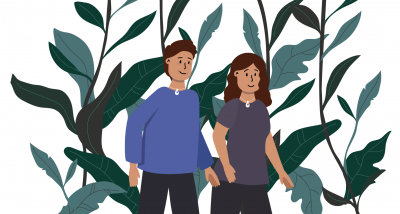
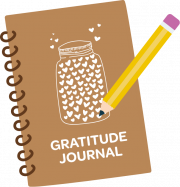 Practising gratitude can improve your physical, psychological, social, and spiritual wellbeing. By feeling grateful we can improve our mood, sleep better, take better care of our bodies and minds, and improve our relationships with others.
Practising gratitude can improve your physical, psychological, social, and spiritual wellbeing. By feeling grateful we can improve our mood, sleep better, take better care of our bodies and minds, and improve our relationships with others.
You can practice gratitude by keeping a journal and simply writing down three things you feel grateful for each day. You can do this at whichever time suits you best. You can also keep a visual diary of things you are grateful for by taking pictures. For example, you may be grateful for lovely weather on a sunny day. Read more about gratitude and its benefits.
Spending time outdoors and connecting with our natural world is important for our physical, mental, and spiritual wellbeing. You can enjoy the natural beauty that Aotearoa has to offer by exercising, gardening, reading, creating art outside, or having a picnic with your loved ones.
If you live in an area where there is not much nature around, try bringing the outdoor to you with plants, flowers, herbs or even photos or paintings of your favourite landscapes. Read more about how to thrive with nature.
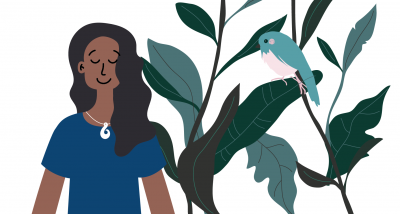
Sleep is necessary for your brain and body to repair and replenish your energy. Read some tips on how to improve your sleep quality.
How we feel physically has an important relationship to how we feel emotionally. Regular and nutritious meals are important to replenish your energy and ensure that your body is getting the vitamins, minerals, and proteins that it needs to support your daily life. Now may not be the time to make big changes to your diet, but often simple changes can make a big difference, for example: choosing a wide variety of healthy foods, increasing the amount of fruit and vegetables you are eating, and avoiding alcohol and smoking can all be helpful. Speak to your GP if you require particular help in this area or visit Quitline for support to quit smoking.
Tips on eating well
 |
Eat plenty of fruit and vegetables. Fruits and vegetables are packed with nutrients to boost recovery and prevent a range of diseases. Eat a minimum of 3 servings of vegetables and 2 servings of fruit each day. |
 |
Incorporate some whole grain and high fibre foods in your diet. Try adding some breads, cereals, grains, and starchy vegetables in your diet. |
 |
Fish, chicken, legumes, and lean meat are great sources of protein and nutrients for your diet. |
 |
Limit your processed food and surgary food/drink intake, and alcohol you consume. |
Long COVID can be a stressful experience. Relaxation techniques can help you release tension and feel calm. These techniques have both physical and psychological benefits. Remember that relaxation is a skill, with some time and practise the full benefits of relaxation can be achieved. Try incorporating some of these relaxation techniques in your self-care routine.
You can also try these breathing exercises which will help you catch your breath and ease feelings of worry and panic.
Calm and RelaxedClose your eyes and take a few minutes to focus on your breathing. Breathing in through your nose if that feels comfortable for you.
|
Muscle relaxing breathing
|
 |
Coping with brain fog or cognitive changes |
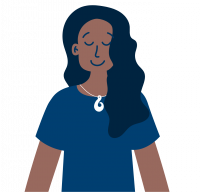 Brain fog, which you might hear referred to as ‘cognitive dysfunction’, is a commonly reported symptom of Long COVID. People describe their thinking being slowed down, having trouble remembering things, having difficulty concentrating or focusing on tasks, having trouble tolerating loud noises, and finding it hard to find the words to say things. These symptoms can have a big impact on usual daily activities such as work or study as well as the ability to socialise.
Brain fog, which you might hear referred to as ‘cognitive dysfunction’, is a commonly reported symptom of Long COVID. People describe their thinking being slowed down, having trouble remembering things, having difficulty concentrating or focusing on tasks, having trouble tolerating loud noises, and finding it hard to find the words to say things. These symptoms can have a big impact on usual daily activities such as work or study as well as the ability to socialise.
The cause of brain fog isn’t well understood and appears to be somewhat individual. However there are some factors that we know can contribute to or worsen people’s brain fog including pain, fatigue, shortness of breath, overdoing physical activities and changes in mood.
While there's no one-size-fits-all treatment that can cure these cognitive difficulties, there are things that we know can help you manage them:
- Use pacing strategies to conserve your mental energy
- Take regular breaks
- Use a calendar or write things down to help your memory
- Get good sleep
- Engage in good self-care such as avoiding alcohol and drugs, and eating well
- Engage in regular, safe amounts of exercise
- Try regular relaxation, breathing exercises or meditation
- Remind yourself that this is a common symptom of Long COVID and that you are not alone
- Seek the help of a health professional if needed.
Here are some suggestions for managing brain fog from people with experience of Long COVID:
“I put a white board in my room to note to dos. Then make a clear objective/goal I want to achieve each day before I start my day. Otherwise, I kind of just forget what I’m doing a lot.”
“Take a break from screens. Listening to an audiobook or music can be relaxing. If you need to work on a screen, 15-30 min blocks then 10 minute rests work well.”
“I have a whiteboard in kitchen that I note anything happening that week + grocery list, so I’m not worrying about forgetting things. Using calendar on phone for reminders.”
“It's truly scary when your brain doesn't function like it normally does. It will improve but it takes time. Reading may be hard but treat it like exercise. Start with a few pages a day and build your way up if you have too. Meditate and practice relaxation techniques. They really do help more than any drug. There are free apps for this. They take time and practice to master. So be persistent and patient.”
“Don't try and multi-task, now is the time to do one thing at a time. If you feel fog coming on, go lie down, close your eyes and take some really deep breathes. It's okay, you've got this.”
“Work in smaller increments and go rest regularly to recharge. Partial workdays are much better to achieve this. The Brain Fog will gradually reduce over time. If you get a clear day/hours, try to manage excitement/expectations as it can be really easy to overdo it (with a big backlog of stuff) and the fog usually comes back.”
“I keep a diary to record my symptoms. Record things to do I can't remember.”
 |
Managing fatigue and pacing |
It is normal to feel tired or fatigued with Long COVID, however inactivity for long periods can worsen fatigue, muscle and joint pains, and other fitness and mood related symptoms. It is important to balance rest and activity, and to not forget about your enjoyment. Once you notice steady improvements in symptoms, you will be able to gradually increase your activity levels.
What people with Long COVID say to do to help manage fatigue:
“You can't just push through this illness like you may have been able to in the past. Remove physical and mental stress as much as you possibly can. Start small. A walk to the end of the street and back. Over time slowly build up. It may be 100m further. Log the progress in a journal for your own sanity. Progress is very slow but it happens and you can lose sight of that.
“Rest, rest, rest. But first, learn how to truly rest. Take time off work.”
“Rest. Don’t feel the need to do anything. Let it go. Now is the time to rest and let others do things for you.”
It is common for people experiencing Long COVID to have good days (where your symptoms aren’t as bad) and bad days (where your symptoms are worse). It is important to resist the urge to do too much on your good days which can lead to a cycle of ‘boom and bust’. Try to be patient and pace yourself.
Pacing is a helpful evidence-based technique used to increase daily activity and fitness while managing pain and fatigue symptoms. Pacing can allow you to steadily improve your activity levels without risking exhaustion or worsening any symptoms.
Long COVID symptoms may change how much activity you can manage, how enjoyable these activities are, or how long it takes you to do them. Pacing can help you manage symptoms such as fatigue, brain fog, muscular or joint pain and numbness. Pacing strategies can help avoid breathlessness, headaches, pounding heart, or worsening fatigue by preventing over-exertion.
Here are some tips on how to practice pacing. It can be split into three key steps:
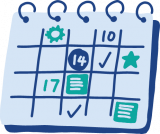 1. Plan
1. Plan
Planning each day in advance helps you to lay out any goals that you are working towards, or tasks and activities that you need to complete. Try building a daily routine and space out your activities and tasks to allow for rest and re-energising in between.
- You may find it helpful to alternate between different types of activity e.g., alternating between mental and physical tasks.
- Break up bigger tasks into smaller, manageable chunks. For example, instead of completing all your household chores in one day, complete one small chore each day.
- Be sure to balance your essential activities with some enjoyable and energising ones.
- Be flexible with your plans, if you feel too tired to continue, take a rest and try again tomorrow. Taking frequent yet short breaks are better than a few longer ones.
- It is important not to be harsh on yourself by comparisons with other people’s experiences, or how much work you could do before long COVID. It may take a few tries to get your planning right.
- Once you notice a sustained improvement in symptoms, gradually increase your activity levels.
- Keeping an activity diary can help you with planning and prioritising. Download your own activity diary.
- Tracking your symptoms can help you monitor improvement or identify persistent concerns that may need GP advice. Download symptom tracker.
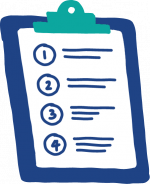 2. Prioritise
2. Prioritise
Experiencing symptoms such as fatigue or pain may make it difficult to manage your usual routines. You may find yourself being unable to meet your usual work or fitness demands. Remember to be kind to yourself, it is okay if you cannot finish all the tasks you wanted to complete in a day. Prioritising your activities and tasks can help you complete your important activities and essential tasks without over-exerting yourself.
You may find yourself feeling more active during certain times of the day. Prioritise your important tasks by planning to do them when you have the most energy.
3. Delegate
 Delegating or planning your tasks can help you save energy. Examples include doing your cooking in the weekend to prepare for the week ahead or grocery shopping online. Importantly, you do not have to go through long COVID alone. Reach out to your friends and whānau and let them help with challenging tasks such as shopping, preparing meals, or driving if they can.
Delegating or planning your tasks can help you save energy. Examples include doing your cooking in the weekend to prepare for the week ahead or grocery shopping online. Importantly, you do not have to go through long COVID alone. Reach out to your friends and whānau and let them help with challenging tasks such as shopping, preparing meals, or driving if they can.
“Your energy is precious. Dedicate it wisely. This illness can be both isolating and debilitating. Prioritise your mental well-being by staying connected and focusing on the things you love. This is more important than chores. Don’t be afraid to ask for help. You can always ‘pay it forward’ when you’re feeling well again.”
 |
Managing headaches |
Headaches are common during viral infections and usually disappear within a few weeks, however, some people continue to experience headaches many weeks or months after a COVID infection. The presence of a headache does not mean that the virus is still present. Many factors other than a viral infection such as diet, fatigue, lack of sleep and stress can contribute to your headaches. Long COVID headaches may be more frequently experienced in those who have a history of experiencing migraines or headaches. Try some of the tips listed below to help you manage headaches:
- Stress can be a common trigger for headaches. Practising self-care and relaxation techniques can be helpful to manage stress or changes in mood. Muscle relaxation techniques may be helpful to reduce stress, and tension in the neck and shoulders.
- A regular sleep schedule is important for your recovery and may help with pain, fatigue, and headache symptoms.
- If you identify triggers such as stress, alcohol, or caffeine, try to avoid them.
- Maintain a regular and nutritious diet and keep yourself hydrated during the day.
- If you experience feelings of exhaustion along with your headaches, try the pacing technique.
- Take your medications or painkillers as prescribed. It is a good idea to speak to your healthcare provider if you experience worsening headaches or dizziness.
 |
Keeping track of your symptons |
Because long COVID symptoms vary so much from one person to the next it can be beneficial to track your symptoms. This will help you and your health professionals to better understand which symptoms you are experiencing and how these are impacting you, see if there are any patterns in your symptoms and monitor any changes over time. You can do this by noting down on paper, or on your phone, the type and severity of your symptoms and when you experienced them.
 |
Getting a good night's sleep |
Sleep is important on a physical, emotional and psychological level. Sleep allows our bodies to rest and recover physically, mentally and emotionally. Sleep energises us and allows us to consolidate our experiences and information from the day. It also plays a key role in helping with our mood and emotional stability.
Sleep and Long COVID
Sleep difficulties are common in times of stress or change. Experiening Long COVID can be stressful and this may lead to difficulties falling asleep, staying asleep, or waking up too early. Long COVID symptoms, racing thoughts, worry, or a disrupted routine may also be contributing to sleep difficulties.
Sleep hygiene practices are effective in managing sleep difficulties and improving quality of sleep. Read the sleep hygiene tips below:
Sleep basics
- Avoid alcohol, nicotine, or caffeine intake for at least two hours before sleep
- Remove any distractions from your environment including light and noise and avoid screen time for at least an hour before bedtime.
- Do not go to bed hungry or thirsty but try to avoid heavy meals before bedtime.
- Adjust your bedroom lighting, air quality, and temperature to your comfort if possible.
- If you are feeling too hot or too cold, think about adjusting your bedding or taking a shower before bed.
Changing behaviour and other helpful practices
- Stick to a regular wake and sleep time every day.
- Create a bedtime ritual to prepare for sleep. Your wind down routine could include practising some relaxation techniques, listening to soothing music or a podcast, or enjoying a quiet read with warm milk or herbal tea.
- If you feel worried or anxious when trying to sleep, try some relaxation techniques.
- If you experience too many worries or spinning thoughts when trying to sleep, try scheduling a worry-time into your day. Scheduling a brief period for worry-time during the day will allow you to note down or discuss your worries with your whānau, so you can have a clear mind before sleep.
- Keep a notepad at your bedside to jot down and park thoughts that pop up when you're trying to sleep.
- Do not complete work from bed, try to keep your bed for sleep and intimacy only. This will help you link your bedroom with sleep rather than your day activities so that your body and mind will know that when you go to bed it's time to sleep.
- Prevent associating lying in bed with wakefulness. If you are unable to fall asleep within 30-minutes, get up from bed and do a quiet activity until you feel ready to sleep.
- If you are really tired during the day, find time to have a nap. These shouldn't impact night time sleep if they are short (e.g., 30-minute power naps) and not too late in the day.
 |
How to exercise safely |
Exercise is important to improve strength, endurance, prevent health problems, reduce stress, and increase your energy levels. Symptoms such as fatigue, pain, breathlessness may make exercise difficult during this time. You may notice that your usual level of exercise, or even small amounts of activity have become difficult to manage. It is important to be aware that returning too quickly to intense exercise can worsen Long COVID symptoms. A gradual increase in exercise is important to safely manage your symptoms and prevent injury or exhaustion. If you are experiencing muscle or joint pains, feeling low in energy, or feel that your symptoms worsen after activity, try slowly increasing your exercise according to the five phases below.
Remember to stay on each phase for at least 7 days, and only move to the next phase if you do not feel fatigued or that your symptoms have increased. Drop back a phase if you experience setbacks in your symptoms.
Caution: If you feel chest pain, dizziness, lightheaded, or nausea, stop exercising and contact your healthcare provider. See your GP for a referral to a physiotherapist if you have ongoing concerns about exercise.
Phase 1 - gentle exercise that you can complete with ease.
This phase focusses on preparing you for a return to exercise.
Example exercises: Try practising breathing techniques, take a gentle walk, perform stretches, or balance exercises. You may do stretches while sitting or standing. Hold each stretch for 15-20 seconds.
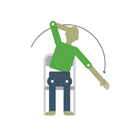 |
Reach your right arm up to the ceiling and then lean over to the left slightly; you should feel a stretch along the right side of your body. Repeat on the other side. |
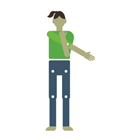 |
Put your arm out in front of you. Keeping your arm straight, bring it across your body at shoulder height, using your other hand to squeeze your arm to your chest so you feel a stretch around your shoulder. Repeat on the opposite side. |
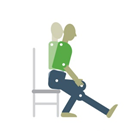 |
Sit on the edge of a chair with your leg out straight in front of you with your heel resting on the ground. Place your hands on your other thigh as support. Sitting as tall as you can, bend slightly forward at your hips until you can feel a slight stretch down the back of the leg that is stretched out. Repeat on the opposite side. |
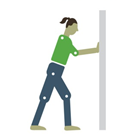 |
Stand with your feet apart, lean forward onto a wall and step one leg behind you. Bend your front knee, keeping your back leg straight and your heel on the floor. You should feel a stretch in the back of your lower leg. Repeat on the opposite side. |
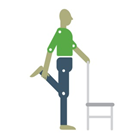 |
Stand up and hold onto something sturdy for support. Bend one leg up behind you, using the hand on the same side to hold your ankle or the back of your leg. Take your foot up towards your bottom until you feel a stretch along the front of your thigh. Repeat on the opposite side. |
Phase 2 - low intensity exercises
You should not face any breathing difficulties while doing Phase 2 exercises.
Example exercises include walking, doing light household or outdoor gardening tasks. If you can do these activities while holding a conversation with someone, you can increase the time you spend doing these activities by 10-15 minutes each day.
Phase 3 - moderate intensity exercises
Exercises in phase 3 may make you breathe heavily, but you should be able to have a conversation with someone while doing them.
Example exercises are brisk walking, climbing up and down stairs, jogging, introducing slopes or inclines to your walks, and performing resistance exercise.
Phase 4 - moderate intensity exercises which also train your coordination and functioning skills
Example exercises are running, cycling, swimming, and dance classes.
Phase 5 - baseline exercises
At this phase you should be able to do the types of exercise and activities that you could do before you got COVID-19.
 |
Talking about Long COVID |
Talking to people about your experiences with Long COVID can be hard, particularly if they have no experience or knowledge of the condition. Although it's hard, trying to hide it from friends or whānau can be difficult and stressful.
Remember you don't have to tell everyone everything, take time to think about what you want to disclose and how much information you feel comfortable others knowing. Let them know what you need from them, such as practical or emotional support.
"Explain to others that you're unable to do what you used to be able to, it's hard to pull back from activities, but it's needed, or you just get worse."
Tips for talking about Long COVID with health professionals
- It is useful to be prepared for appointments by writing down any questions you want answers to befoe you go into the consultation. If you have been keeping track of your symptoms make sure you take this information with you.
"If going to the doctor, prepare a note of your questions and symptoms so you don't have to try and remember them when you get there."
- It's ok to ask qeustions if you don't understand or want more information.
- If a doctor uses terms you do not understand it is ok to ask for clarification.
- It may be worthwhile taking notes during the session or take someone else along who can take notes for you so that you can refer to the information later on.
Tips for talking about Long COVID with your employer
- It is useful to be prepared for conversations with your employer or manager, prepare notes in advance and consider having a support person present if you feel you want the extra support.
- Take time to consider what you need. For example do you need time off, more flexibility or changes in your duties.
- Talk to your doctor about documentation (e.g. medical certificate) if you think your employer might require this.
- The NZ Long COVID Support group have put together a resource for workplaces whch you could share with your employer.
 |
Coping with persistent loss of smell or taste |
It is common to experience a loss or change in sense of smell and taste following a viral infection. Most individuals recover their sense of taste and smell within a couple of weeks of getting COVID, however, some individuals can take months to recover. If you are experiencing a persistent loss of smell or taste with Long COVID, try these tips below:
- Practise oral hygiene by brushing your teeth regularly and rinse your mouth with water if it feels dry or uncomfortable.
- A loss of smell and taste may make certain foods (kai) less appealing to you, however, it is important to have regular and nutritious meals to support your recovery.
- Unless you have been recommended a particular diet from your healthcare professional, you may find changing the flavour, texture, and temperature of food helpful. For example, you may prefer to add more herbs and spices to food if you are finding meals bland. Alternatively, if you have an unsettled stomach, you may find bland flavours easier to eat. Your preferences may change regularly, so it can be useful to retry certain foods and flavours over time.
- For a persistent loss of smell, try smell training by sniffing a lemon, rose, clove, and eucalyptus for 20 seconds each, twice a day.
- If you are having any difficulty in swallowing, or are struggling to maintain your weight, contact your healthcare professional to seek expert advice.
- If you continue to experience persistent loss of smell/taste, sometimes medications might help. Talk to a healthcare professional about your options.
 |
How to manage breathlessness |
Breathing Techniques
Breathlessness may occur for a lot of reasons. If you feel out of breath during activities, or are struggling with cough, racing heart, or feelings of fear or panic then try these breathing exercises. Your breathlessness should improve as you gradually increase your activites. View the section on exercise.
Changing position regularly can make it easier to breathe while in bed or can ease your symptoms during activities. If you get breathless during activities, try changing your position as pictured below to ease your symptoms.
Positions to Ease Breathlessness






